by Todd Rutherford
You may have heard recent dire reports about the health of bees and butterflies. Whether it’s the declining number of the amazing Monarch Butterfly or the constant reports of “colony collapse disorder” in beehives, these reports are alarming. One of the best and easiest things you can do to help these crucial creatures survive and thrive is to plant the perennials, shrubs and trees in your landscape that will give bees and butterflies the food they depend on. Help these pollinators while creating an inviting outdoor space for yourself. Or, if you are pondering the possibility of updating your landscaping in the near future, let Outdoor Design Group design a bee and butterfly friendly garden for you.
Below are listed several different perennials, shrubs and trees that provide food for bees, butterflies and other pollinators. While I’ve listed several pollinator friendly plants here, there are still many more to choose from. Consult the Xerces Society, a nonprofit organization that protects wildlife through the conservation of invertebrates and their habitat, or your local university extension agent for more suggestions of pollinator friendly plants that will grow well in your area.
Perennials for Butterflies and Bees
Asclepias species. Commonly referred to as the Milkweeds due to their milky sap, there are many species in the Asclepias genus that are utilized by butterflies and bees. Many biologists believe that the decline in the Monarch butterfly population is directly correlated to the increasing use of herbicides used to kill Milkweeds in North America, because Monarch butterflies depend on Milkweeds as food for their larvae. There are many Asclepias species that grow in North America, but two that do well in Colorado are Asclepias tuberosa (showy milkweed) and Asclepias speciosa (butterfly weed). Ht. and Wd. varies depending on species and cultivar, generally 15-60” Ht. x 12-18” Wd.
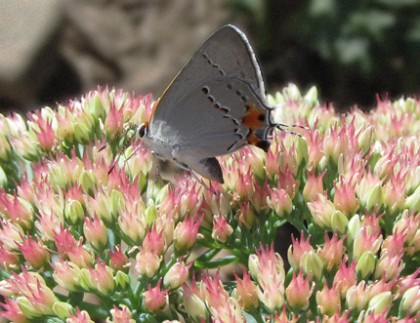
The Mint Family (Lamiaceae). Many familiar and popular garden plants from the so-called Mint Family are favored by bees. Some of these are culinary sage, Russian sage, mint, basil, rosemary, oregano, thyme, lavender, lamb’s ear, hyssop, lemon balm, and bee balm. Ht. and Wd. varies depending on species and cultivar.
Sedum ‘Autumn Joy’. This tall stone crop flowers in mid to late summer (see photo above), making it a good late-season nectar source for pollinators when many other plants have stopped flowering. 18-24” Ht. x 12-18” Wd.
Datura wrightii Although Sacred Datura may not always be a perennial in all parts of Colorado, depending on the severity of the winter, bees love it’s flowers which emit an amazing scent, so even if it is frost tender and may need to be regrown from seed in colder areas, it is worth it. The bees will thank you. 18-24” Ht. x 6-8’ Wd.
Shrubs for Butterflies and Bees
Buddleia alternifolia ‘Argentea’, Silver Fountain Butterfly Bush. This butterfly bush blooms earlier than the other species and cultivars of Buddleia. This large shrub does well in most soils and sites but doesn’t like its roots to stay wet. 12-15’ Ht. x 10-12’ Wd.
Caryopteris x clandonensis ‘Blue Mist’. Blue Mist Spirea is also in the Mint Family, and is not a true spirea, but has flowers that resemble those of the spirea. It is a hybrid of C. incana x C. mongolica that was created in the 1930’s in England by Arthur Simmonds. There are several cultivars of Caryopteris x clandonensis that are good choices for Colorado and which bees and butterflies (see photo below) love. 3-4’ Ht. x 2-3’ Wd.
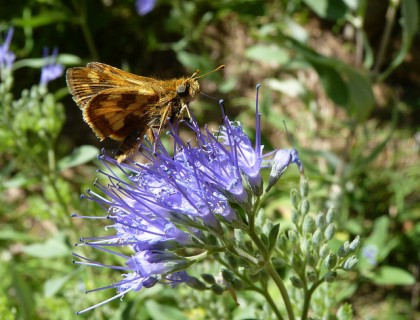
Mahonia. This genus has several members whose flowers will delight your winged friends. Mahonia aquifolium is a familiar shrub known as Oregon Grape Holly. It is evergreen, easy to grow and produces edible (but not tasty) berries from the yellow flowers that bees appreciate. 4-6’ Ht. x 4-6’ Wd.
Prunus bessyi, Sand Cherry 4-6’ Ht. x 4-6’ Wd.
Philadelphus lewisii, Cheyenne Mock Orange 5-7’ Ht. x 4-6’ Wd.
Rhus aromatica ssp. Trilobata, Three leaf sumac 3-6’ Ht. x 3-6’ Wd.
Rosa woodsii, Wood’s Rose 3-6’ Ht. x 3-6’ Wd.
Trees for Butterflies and Bees
Tilia cordata, Little Leaf Linden. Linden trees perfume the air in springtime and offer up small yellow flowers (see photo below) for pollinators. I’ve heard that in Eastern Europe, a type of beer is flavored with the linden flowers. 30-50’ Ht. x 25-35’ Wd. (depends on cultivar).
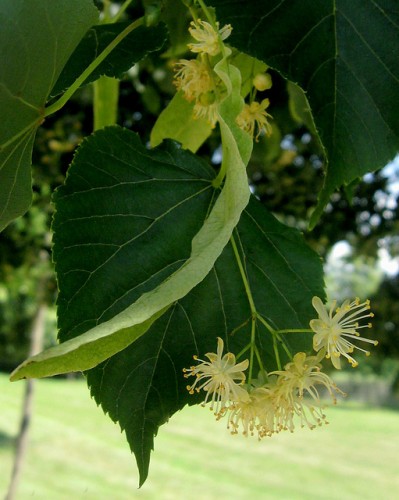
Apple / Crabapples. The Malus genus offers many species and cultivars that are attractive to bees. In fact, if there were no bees, you probably would not get any fruit from your apple trees. Ht. and Wd. varies depending on cultivar.
Prunus armeniaca ‘Moongold’, Moongold Apricot. 15-25’ Ht. x 15-25’ Wd.
Prunus nigra ‘Princess Kay’, Princess Kay Plum 15-20’ Ht. x 10-15’ Wd.
Catalpa speciosa, Western Catalpa 40-60’ Ht. x 30-50’ Wd.
Cercis Canadensis, Eastern Redbud 20-30’ Ht. x 20-30’ Wd.
Crataegus ambigua, Russian Hawthorne 15-25’ Ht. x 20’ Wd.
This is the official blog of Outdoor Design Group, Colorado Landscape Architects. For more information about our business and our services, click here.
Related Posts:
by Matt Corrion
1) Ditch the bluegrass turf lawn, completely or partially. Bluegrass turf uses far more water than alternative landscaping choices.
2) Set your mower on its highest setting so turf grass is not cut too short. Longer grass keeps the soil cooler and reduces evaporation.
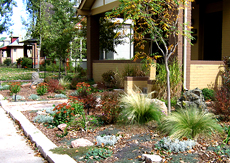
Consider redesigning your landscape so it requires less water and looks more interesting
3) Use the mulch setting on your lawn mower so grass clippings stay on the lawn, which helps slow evapotranspiration and provides nutrients to the soil.
4) Do not install bluegrass turf on slopes, especially south facing slopes, because much of the water will run off the slope and sprinklers will need to run for longer times to compensate. Instead consider planting shrubs or native plants with drip irrigation on a slope.
5) Mulch your trees, shrubs and perennials to reduce water use. Mulch slows down the evaporation of soil moisture, reduces water run-off, and reduces weeds which can steal moisture from your plants.
6) Consider replacing your existing high-water turf lawn with low-water turf options such as buffalo grass, blue grama grass or a fescue grass.
7) Plant native plants that are more appropriate for the climate you live in.
8) If you plant non-native plants, use ones that are adapted to your climate conditions, such as iceplant from South Africa, and Russian sage from Central Asia.
9) Place your plants in groups organized by water use, so as to avoid overwatering low water need plants.
10) Plant trees in your turf lawn to provide shade for the lawn and reduce evapotranspiration of the grass.
11) Follow your water provider’s summer watering rules, and any watering restrictions that may be in place at that time.
12) Don’t water during the hottest time of the day. It is best to water between 6 pm and 10 am. Watering during the hottest time of the day increases the evaporation of the water before it reaches the roots of your plants.
13) Don’t water when it is windy. Just as watering during the hottest time of day increases water loss due to increased evaporation, so does watering when it is windy.
14) When shoveling snow in winter, place snow piles where it will melt and water trees and shrubs that can benefit from extra moisture in winter.
15) Install a rain sensor to avoid having your irrigation system run when it is raining, or the day after a heavy rainfall event.
16) If you don’t have an automatic irrigation system, use a mechanical or digital timer with your sprinklers.
17) If you have an automatic irrigation system, check it once a month or more often to fix any leaks or problems that may occur.
18) Use drip irrigation to water your landscape plants. Drip irrigation is the most efficient form of irrigation because the water is not sprayed into the air which increases evaporation of the water before it reaches the plants.
19) Avoid placing sprinkler heads against fences and hardscape. Instead, install a strip of rock mulch between fences / hardscape and sprinkler heads. In addition to reducing water waste, this minimizes water damage and the need for turf edge trimming.
20) Improve your soils water holding capacity by amending the soil with organic matter.
21) Make your landscape more permeable to keep storm water on your property. Instead of a solid concrete patio, install a unit paver patio to allow water to percolate down rather than running off.
22) Divide watering times into shorter shifts to improve water absorption, and avoid runoff. This is sometimes referred to as the “cycle and soak” method.
23) Direct gutter downspouts to planted areas rather than streets or storm water areas.
24) Save rainwater from your roof for irrigating plants.
25) Save indoor “grey” water for irrigating trees and shrubs.
26) If local codes allow, hire a plumber (or DIY) to pipe your grey water to your landscaping.
27) Use a mild/natural dish soap for washing dishes to keep this grey water safer for your landscape plants.
28) Bathe your pets outside over turf areas that need water, using mild/natural soap.
29) Wash fruits and vegetables outside over your lawn to allow wash water to irrigate the turf.
30) Plant trees (adapted for your climate) to shade your turf area to reduce evapo-transpiration of the turf.
31) Consult a landscape architect or horticulturalist to learn the best plants to use in your climate and growing zone.
32) Before planting certain species of plants, do extensive soil preparations. Some plants benefit from additional organic matter, while others will perform better if drainage is improved.
33) Save fallen leaves in autumn and use as a mulch around trees, shrubs and perennials.
34) Plant new perennials, shrubs and trees in fall when temperatures are cooler because it will take less water to establish them, as compared to planting in early summer.
35) Cover water features, pools and spas when not in use to reduce evaporation.
36) Check water features, pools and spas for leaks.
37) Consider using pondless water features, where the water reservoir is hidden or obscured which provides less evaporation that a typical pond.
38) Don’t use water to clean paving. Use a broom and dust pan.
39) If you want to install a water feature, choose one that cascades or trickles rather than one that sprays in the air. Spraying fountains lose more water to evaporation.
40) If your children want to play in the sprinkler, have them do this in an area of your lawn that needs water.
41) Do not let your children waste water by spraying sprinklers on sidewalks, drive ways or the street.
42) Place large rocks near shrubs, trees or perennials to keep the soil below the rock cool and moist.
43) When refreshing your pet’s water dish, don’t discard the old water in the sink, pour it on plants outside.
44) If you have ice or water left in a take-out cup, or in re-usable glasses, pour it on your landscape plants outside.
45) Don’t discard used ice and water from a cooler in the sink, but throw them outside on your plants.
46) If you wash your car at home with a hose, use a shut-off nozzle so water is not running in between soaping and rinsing the car.
47) Wash the car in a lawn area so that you water the grass at the same time. Use a mild/natural detergent when doing this.
48) Don’t use a hose to clean out your gutters. Consider using a leaf blower or a long handled rake specifically made for the job.
49) Replace old spray nozzles on your irrigation system with newer, more efficient rotary nozzles. They reduce runoff and evaporation. Your purchase and installation of these nozzles may make you eligible for rebates from your water provider. Contact them for more details.
50) Consider hiring a landscape architect to analyze your property and re-design it to require less water and maintenance.
This is the official blog of Outdoor Design Group, Colorado Landscape Architects. For more information about our business and our services, click here.
Related Posts:
by Matt Corrion
The Colorado Front Range has some of the best fall weather to be had in the United States. When it comes to interesting fall foliage color however, Colorado lacks the abundance of color that can be found in other parts of the country. But with the right choice of trees you can enjoy some wonderful foliage fireworks in your own backyard.
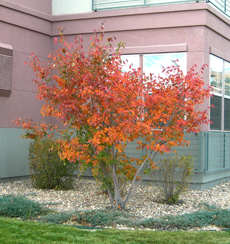 Serviceberry
Serviceberry
Serviceberries are beautiful tree-like shrubs. They offer great spring flowers, edible berries that attract birds and beautiful fall color. They are also good choices for water wise landscapes.
Autumn Brilliance Serviceberry – Amalanchier x grandiflora 12’ Ht x 10’ W
Shadblow Serviceberry – Amalanchier canadensis 12’ Ht x 10’ W
Crabbapple
The popular ornamental trees are renowned for their their spring flowers, but these crabapples provide excellent fall interest as well.
Indian Summer – Malus ‘Indian Summer’ Orange-red fall color. 18’ Ht x 18’ W
Lancelot – Malus ‘Lancelot’ Yellow-gold fall color. 10’ Ht x 8’ W
Prairiefire – Malus ‘Prairiefire’ Orange-red fall color. 20’ Ht x 20’ W
Spring Snow – Malus ‘Spring Snow’ Yellow fall color. 20’ Ht x 20’ W
Ash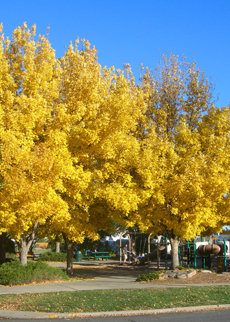
Autumn Purple – Fraxinus Americana As if it glows from within the center of the tree, this Ash is a sight to behold. The color is a mixture of gold to bronze-purple. 50’ Ht x 30’ W
Fall Gold – Fraxinus nigra The bright yellow gold of this tree is great against a crisp blue Colorado fall sky. 40’ Ht x 25’ W
Ornamental Pear
You can find these often planted along streets and in commercial landscapes. They provide spring flowers and fall color in relatively compact form.
Autumn Blaze – Pyrus calleryana ‘Autumn Blaze’ Orange red fall color. 30’ Ht x 25’ W
Chanticleer – Pyrus calleryana ‘Chanticleer’ Orange red fall color in an upright form. 35’ Ht x 15’ W
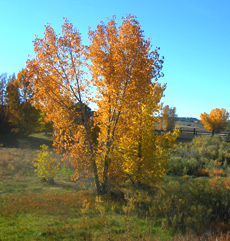 Cottonwood
Cottonwood
Just like their cousin the Aspen, Cottonwoods are known for their yellow gold leaves. Although they are not recommended for residential yards due to their size and tendency to sucker, they are wonderful in large areas with native planting schemes, especially in wetter areas like drainages and ravines.
Plains – Populus sargentii 60’ Ht x 50’ W
Narrowleaf – Populus angustifolia 75’ Ht x 40’ W
Lanceleaf – Populus acuminate 50’ Ht x 30’ W
Maple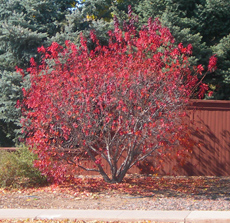
These maple trees will provide great red to orange-red color for your landscape. The Autumn Flame is gorgeous, but it can suffer chlorosis in our alkaline soils. Amur and Tatarian are the most fool-proof choices for our soils and climate.
Amur – Acer ginnala 20’ Ht x 10’ W
Bigtooth – Acer grandidentatum 25’ Ht x 25’ W
Autumn Blaze – Acer x fremanii ‘Autumn Blaze’ 50-40’ Ht x 30-40’ W
Tatarian Maple – Acer tataricum 25’ Ht x 20’ W
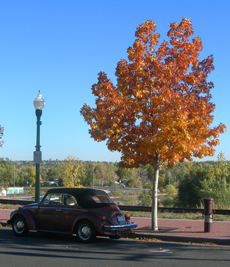 Oak
Oak
Several of the Oak species are wise choices for Colorado Front Range climate and soils. And a few of these offer nice fall foliage as well.
Chinkapin Oak – Quercus muehlenbergii Yellow fall color. 35-50’ Ht x 35-50’ W
English Oak – Quercus robur Golden yellow fall color. 40-60’ Ht x 30-40’ W
Northern Red Oak – Quercus rubra Bronze to wine red fall color. 40-60’ Ht x 40-60’ W
This is the official blog of Outdoor Design Group, Colorado Landscape Architects. For more information about our business and our services, click here.
Related Posts:
by Matt Corrion
Some interesting trends have emerged this year in landscape design. In this article I describe the 5 hottest trends we are seeing – Which of these ideas will you incorporate into your landscape?
Outdoor Stone Fireplaces
Outdoor fireplaces have been around for a long time, but in the last few years they have really gained in popularity. They can serve as a focal point in the design of a backyard landscape, while providing the functional warmth of a fire adjacent to an outdoor patio.
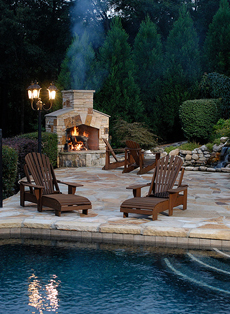 Here in Colorado, where the summers are dry and there are few mosquitoes or other insects, cool summer and fall evenings are perfect for gathering outdoors with family and friends. Outdoor stone fireplaces can add to the ambiance of your outdoor space.
Here in Colorado, where the summers are dry and there are few mosquitoes or other insects, cool summer and fall evenings are perfect for gathering outdoors with family and friends. Outdoor stone fireplaces can add to the ambiance of your outdoor space.
Design Considerations: Outdoor outdoor fireplaces are typically gas burning, unless the property is in a rural area with low fire danger where wood burning is allowed. They can either be custom built using a combination stone, masonry, brick, stucco, or stone veneer; or they can purchased as a prefabricated insert that is put in place and then faced with stone or another decorative material. A combination of decorative stone or concrete caps, mantels, and hearths can also be incorporated, resulting in an almost endless variety of design opportunities.
Due to the increased popularity of outdoor fireplaces and firepits, many municipalities are updating codes and ordinances to provide more specific restrictions and design guidelines. The required distance between the fireplace and any structure may vary between 15 to 25 feet. Always make sure your landscape architect or contractor has checked with your local building department on the current rules and regulations.
Pondless Water Features
Water is one of the building blocks of life. Water features can add a calming effect to your landscape through the sounds and movement of water. They can also mask unwanted noise and bring a peaceful calm to the hustle and bustle of urban living.
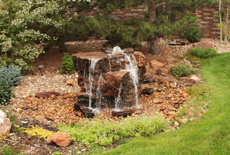 The problem with most water features is that they are high maintenance. While a natural looking pond can be beautiful, they are difficult to construct and can require quite a bit of maintenance. If that maintenance is neglected, or the pond is not constructed correctly one is left with pond that leaks, one does not look natural, or lacks the proper balance of plants, fish, and filters to keep the water clean.
The problem with most water features is that they are high maintenance. While a natural looking pond can be beautiful, they are difficult to construct and can require quite a bit of maintenance. If that maintenance is neglected, or the pond is not constructed correctly one is left with pond that leaks, one does not look natural, or lacks the proper balance of plants, fish, and filters to keep the water clean.
“Pondless” water features solve most of these issues, and are the hottest trend in water feature design. In a pondless water feature, and underground basin in purchased and installed below the ground to hold the water that is circulated through the feature.
A grate is often placed over the basin, and covered with rocks to allow the water to run through to the basin below. The water is pumped from the basin over a decorative rock or sculptural feature. The sound of water is achieved not only from the above ground feature, but by the water splashing through the rocks and into the basin below. And because the basin below ground is shaded from the sunlight, algae will not grow in the water.
Design Considerations: Depending on the size of the feature and how often you intend to run it, you may opt to install a filter and an auto-fill valve connected to a water supply to keep the feature full. You may also opt for an on/off switch for the feature at the home so you can easily turn it on or off. Don’t forget to plan for lighting the feature at night. And finally, when selecting a pump always error on the side of a larger pump, because the flow of water can always be dialed back but can never be increased.
Natural Lawns
As water prices continue to rise, homeowners and businesses are looking for alternatives to the traditional bluegrass lawn. As I have written about in the past, there are many advantages to making your landscaping more efficient, and reducing the amount of bluegrass lawn is the best way to do that.
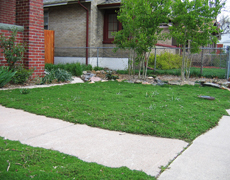 There are many types of plantings that can be used to replace a traditional lawn, but in each case the general principles are the same: plants with reduced watering requirements that require less maintenance. This can we achieved with alternative turfgrasses, Xeriscape plantings, edible garden plants, monocultures of spreading shrubs or perennials, native plants, non-natives, natural meadows, or a combination of these elements.
There are many types of plantings that can be used to replace a traditional lawn, but in each case the general principles are the same: plants with reduced watering requirements that require less maintenance. This can we achieved with alternative turfgrasses, Xeriscape plantings, edible garden plants, monocultures of spreading shrubs or perennials, native plants, non-natives, natural meadows, or a combination of these elements.
Another driver in the popularity of the “natural lawn” concept is the desire of individuals and organizations to move away from using pesticides, herbicides, and fertilizers in large quantities- for the benefit of the environment and human health. Children often play on lawns and in our parks. So in addition to replacing traditional lawns, some people are turning to more organic and natural methods of lawn care.
Design Considerations: It is important to realize that less maintenance does not necessarily mean easier maintenance (at least initially). What I mean by that is a more complex planting such as a Xeriscape with many types of plants, or a natural meadow, will take more analysis and careful monitoring than a simple lawn. However, this monitoring and analysis will be more than made up for by the savings in time and resources by avoiding all of that mowing, edging, aerating, fertilizing, etc. that a traditional lawn would require.
Covered Outdoor Patios
Covered outdoor patios work great for blending indoor and outdoor living space. Over the last decade outdoor patios and gardens have been increasingly utilized as an extension of indoor space.
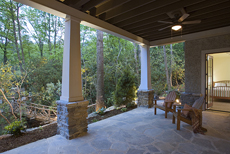 The latest trend is to build a waterproof roof structure over the top of an outdoor patio space. The roof structure is multi-functional, providing shade from the hot afternoon sun as well as protection from the rain and snow. Overhead roof structures also create a more intimate feeling space, creating an outdoor room at a much lower cost than adding a fully enclosed indoor room to a dwelling.
The latest trend is to build a waterproof roof structure over the top of an outdoor patio space. The roof structure is multi-functional, providing shade from the hot afternoon sun as well as protection from the rain and snow. Overhead roof structures also create a more intimate feeling space, creating an outdoor room at a much lower cost than adding a fully enclosed indoor room to a dwelling.
Another benefit to a covered outdoor patio is that outdoor amenities can be protected by the weather. Flat screen televisions, ceiling fans, outdoor kitchens, bar areas, speakers, and lighting can all be incorporated into this outdoor space.
Design Considerations: There are numerous design decisions that need to be made when designing a covered outdoor patio. Will the cover be attached to the home, or free-standing? Support columns for the roof structure can be designed with stone bases. The “ceiling” of the enclosure is also an important design element that should be carefully considered as it will probably be the main surface that you will see when using the space.
Urban Gardening
As the farming industry continues to get more commercialized and corporate, there has been a pushback in the form an increased demand for local farmers markets. And there is no place more local than one’s own yard.
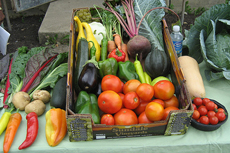 As individuals strive to have more control and knowledge of where their food comes from and how it is grown, many are turning to growing their own produce. Growing a garden is nothing new- however today’s gardens are getting larger and taking up a bigger percentage of the yard. In some cases, urban gardening is being used for an entire backyard or a good portion of a front yard.
As individuals strive to have more control and knowledge of where their food comes from and how it is grown, many are turning to growing their own produce. Growing a garden is nothing new- however today’s gardens are getting larger and taking up a bigger percentage of the yard. In some cases, urban gardening is being used for an entire backyard or a good portion of a front yard.
The urban gardening trend jives perfectly with the “natural lawn” trend. While some people are replacing their traditional lawn with decorative Xeriscapes, others are replacing their lawns with edible gardens. But even edible gardens can be beautiful- there are many decorative herbs that get showy flowers, and some produce such as bright red and yellow peppers can add visual interest to the landscape.
Design Considerations: If you are considering expanding or adding edible garden space there are a few aspects to be mindful of. If you have a homeowner’s association, remember to check their rules on gardens. Consider using decorative paths between your beds, and attractive raised planters can be utilized to keep the space looking a little more organized. Finally, be mindful of pests and rodents that may be attracted to the garden.
This is the official blog of Outdoor Design Group, Colorado Landscape Architects. For more information about our business and our services, click here.
Related Posts:
by Matt Corrion
You may have heard that you can save big bucks on water and maintenance by renovating your landscaping to be more water-efficient.
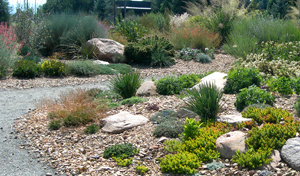
But, did you know that Cities across the country will pay you cash to do it?
As water supplies dwindle and populations rise, many municipalities are offering great incentives for reducing water use in the landscape. When property owners, businesses, or managers factor in the payback from these rebates along with the water and maintenance savings, a landscape renovation can make a lot of sense.
The 2 Main Types of Rebates
Generally speaking, incentives for reducing water use fall into two categories. The first category is paying customers to remove landscapes that have high water use and replace them with attractive low water use plantings, and the second category is to provide rebates for purchasing and installing irrigation components that reduce water use and that are more efficient than older systems.
As we have discussed in the past, the real water savings (as well as the largest rebates) come from replacing high water use lawns and landscaping, with new plantings that require less water and are more adapted to the local climate. There are many benefits to this approach- see The Top 10 Benefits of Making Landscaping More Water Efficient.
14 Specific Examples of Rebate Programs
Incentives for Removing Turf: $0.75 per square foot for single family homes and multi-family or commercial properties.
Equipment Rebates: Rebates for smart controllers, rain sensors, rotary nozzles, and equipment for removing sod and placing compost.
Additional Program Notes: Rebates of up to $150.00 are also offered for rainwater collection systems, and with the installation of a rainwater collection system the incentives double to $1.50 per square foot. Residents may also receive a $20.00 credit for attending a water efficiency class.
Equipment Rebates: Rebates for smart water controllers, weather sensors, and moisture sensors for single homes and multi-family or commercial properties.
Additional Program Notes: Rebates include 50% of the purchase price for valves, and $75.00 per drip zone installed.
Incentives for Removing Turf: $1.00 per square foot, up to $10,000 for single family homes, and up to $25,000 for multi-family or commercial properties.
Additional Program Notes: Rebates are also available for removing old hardscapes, and for seeding areas with native grasses.
Incentives for Removing Turf: $18.50 per 1,000 gallons of water saved for multi-family or commercial properties.
Equipment Rebates: Single family residential customers can receive $2.00 per efficient nozzle and $100.00 for weather-based smart controllers with rain sensors. Multi-family or commercial properties can receive $2.00 per efficient nozzle, and 25% of the cost of a smart controller.
Equipment Rebates: Single family residential customers can receive up to $1,000 for installing smart controllers and rain sensors. Multi-family or commercial properties can receive up to $5,000 for installing smart controllers and rain sensors.
Additional Program Notes: Rebates are also available for rotary nozzles, mpr spray heads, pressure reducing drip valves, and backflow prevention devices specifically made for drip systems.
Incentives for Removing Turf: $0.25 per square foot for installing drought tolerant Buffalo Grass for single family homes and multi-family or commercial properties.
Equipment Rebates: Rebates of $50.00 for moisture sensors, and 50% of the purchase price of a drip irrigation system are available for single family homes and multi-family or commercial properties.
Equipment Rebates: Single family residential customers can receive up to $550.00 for installing smart controllers, rain sensors, and rotary nozzles. Multi-family or commercial properties can receive up to $3,550.00 for installing smart controllers, rain sensors, and rotary nozzles.
Additional Program Notes: Rotary nozzle rebates are available for up to $200.00 for single family residential, and up to $2,000 for multi-family or commercial properties. Rebates are available for 50% of the purchase price of smart controllers and rain sensors.
Incentives for Removing Turf: Rebates of up to $1,650 are available for single family homes and multi-family or commercial properties.
Equipment Rebates: Rebates of up to $250.00 are available for installing smart controllers.
Incentives for Removing Turf: Up to $3,000 for single family homes and multi-family or commercial properties.
Equipment Rebates: Single family residential customers can receive up to $250.00 for installing smart controllers. Multi-family or commercial properties can receive up to $1,250.00 for installing smart controllers.
Additional Program Notes: A minimum area of 1,000 square feet of turf must be removed to qualify for turf removal incentives.
Incentives for Removing Turf: $1.50 to $1.00 per square foot, up to $300,000 for single family and multi-family or commercial properties.
Equipment Rebates: 50% of the cost of smart controllers, and $25.00 for rain sensors for single family and multi-family or commercial properties.
Incentives for Removing Turf: $1.50 per square foot up to $3,000 for single family homes, and $1.50 per square foot up to $9,000 for multi-family or commercial properties.
Equipment Rebates: Single family residential customers can receive up to $400.00 for installing smart controllers. Multi-family or commercial properties can receive $25.00 per station up to 68 stations ($1,700) for installing a smart controller.
Additional Program Notes: Rebates of $0.50 for every gallon of storage capacity up to 400 gallons are offered for rainwater collection systems.
Incentives for Removing Turf: $0.75 per square foot up to $2,000 is available for for single family homes, and $0.75 per square foot up to $20,000 is available for multi-family or commercial properties.
Equipment Rebates: Rebates are available for smart controllers, rain sensors, rotary nozzles, and dedicated landscape meters.
Additional Program Notes: Rebates of $1.50 per square foot up to $30,000 are also available for commercial properties through a “cost sharing areas” program.
Equipment Rebates: Single family residential customers can receive up to $375.00 in equipment rebates. Multi-family properties can receive up to $500.00 for new equipment.
Additional Program Notes: Rain water harvesting rebates of up to $5,000 are available for no-pressurized or pressurized systems.
Incentives for Removing Turf: Rebates of up to $400.00 are available for reducing water bill for single family homes and multi-family or commercial properties.
Equipment Rebates: Rebates of up to $3,200 are available for installing smart controllers, rain sensors, and rotary nozzles.
Additional Program Notes: Incentives are offered for capping irrigation zones and/or converting existing irrigation systems to drip.
These incentive and rebate programs are typically limited to a maximum allowable rebate amount based on the area of the project, and the purchase price of the irrigation components. Many of the programs also are only available on a first come first serve basis. With limited funding many municipalities exhaust their funds in the first few months of the year. Other program requirements include selecting plants from specific drought tolerant or native plant lists, percentage of plant area coverage, and the make and model of irrigation components.
Because of the complexity of the projects and the paperwork involved, it may make sense to have a landscape architect assist you for a moderate fee. These professional consultants can prepare any plans that are needed, submit applications, gain approval from local building departments and HOA’s, and maximize the potential rebate amount you will get back.
In addition, most states require a licensed landscape architect to prepare plans for any major renovation on a commercial or larger residential property. The fees for these services are often offset by the savings that come from having a good plan that can be accurately bid and installed by contractors.
So, if you are looking to make your property more sustainable, update it’s image, and save on maintenance and water, look into what programs may be available in your area.
This is the official blog of Outdoor Design Group, Colorado Landscape Architects. For more information about our business and our services, click here.
Related Posts:





 Serviceberry
Serviceberry
 Cottonwood
Cottonwood
 Oak
Oak
 The problem with most water features is that they are high maintenance. While a natural looking pond can be beautiful, they are difficult to construct and can require quite a bit of maintenance. If that maintenance is neglected, or the pond is not constructed correctly one is left with pond that leaks, one does not look natural, or lacks the proper balance of plants, fish, and filters to keep the water clean.
The problem with most water features is that they are high maintenance. While a natural looking pond can be beautiful, they are difficult to construct and can require quite a bit of maintenance. If that maintenance is neglected, or the pond is not constructed correctly one is left with pond that leaks, one does not look natural, or lacks the proper balance of plants, fish, and filters to keep the water clean.


